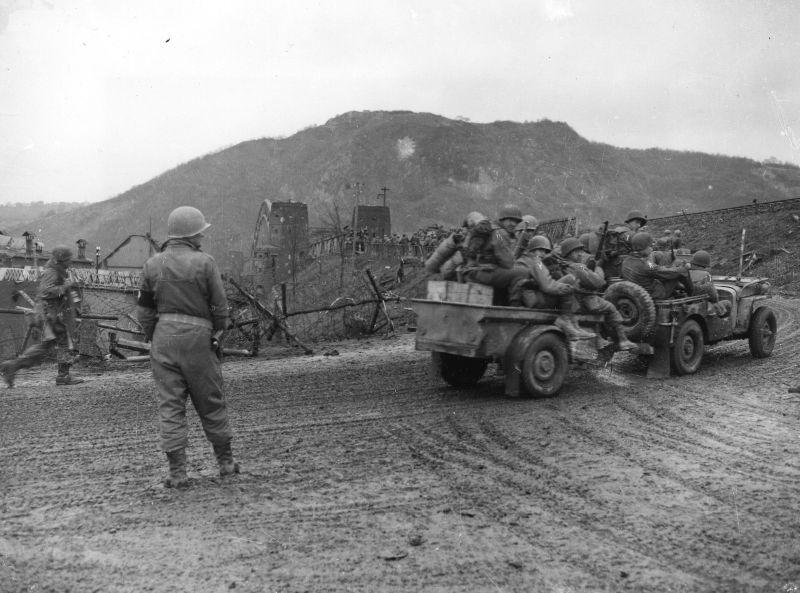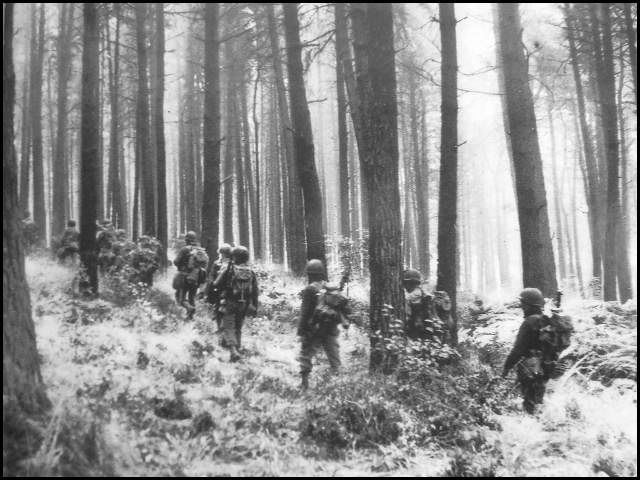– The Battle of the Rhineland –
Early September 1944, General Craig reminded his 9th Infantry Division troops that they had advanced almost 600 miles against enemy opposition, captured over 28000 prisoners and participated in three major campaigns in June, July and August 1944, with no more than 5 days out of action in a period of 3 months. At Dijon in France the U.S. 7th Army linked up with the U.S. 3rd Army. The Battle of France was officially over.
By the afternoon of September 12th 1944, no less than three American units had laid claim to having set foot on German soil. General Craig now had his orders: The 9th Infantry Division was to break through the German West Wall, the Siegfried Line, and push through into the Ruhr River area. A new long battle was about to begin.
After a 3 day battle the 47th Infantry Regiment was the first Allied unit to completely break through the Siegfried Line on September 17th 1944. Pillboxes were defended tenaciously. It took Artillery, Anti-Tank rockets, smoke, 24 pounds of dynamite, detonation of 18 Teller mines and 400 pounds of TNT to force 38 occupants of just 1 pillbox to surrender after 12 hours! It comes to no surprise that the Germans had broken eardrums and were suffering from severe shock. The 15th Engineers were of inestimable help. On September 16th, they bridged the Ruhr River at the town of Monschau. This was the first bridge across that turbulent stream. Carrying flame throwers and dynamite strapped to their backs, the Engineers assaulted pillbox after pillbox under heavy enemy fire. During this period, 14th of September to October 28th 1944, 125 pillboxes were neutralized and 1352 mines and 88 fortifications and obstacles were removed, many of which were booby trapped.
The 9th Division had cleared the southern approaches to the key stronghold at Aachen, contributing to the open jaws of a double envelopment. Supply lines however, were stretched. Fuel and ammunition was being rationed. The capture of the port of Antwerp was essential if the jaws were to be snapped and the thrusts in the north and in the south were to be successful. The port was taken on November 6th and became operative twenty days later.
Into the Hurtgen Forest
Mid-September the 9th Infantry Division also started a series of attacks deep in the Hurtgen Forest. The Hurtgen Forest is a 50 square miles area between Monschau in the south, Duren in the north and east of Aachen. The forest is densely populated with trees, and has rough ridges, steep slopes and hills cut by small streams. Objectives were the village of Germeter and Vossenack, the main road between Monschau in the south and Duren in the north, and several road junctions in that area. Men of the 39th and 60th Infantry Regiment fought through the forest to seize the ridge behind Vossenack, overlooking the dammed up Ruhr River. The mission of VII Corps was to gain control of the Ruhr River dams, although this objective was not primary during the first few weeks of battle. The dams had to be taken after Allied commanders feared that the Germans might blow the dams and flood the grounds east of the city of Aachen. The battles for the men of the 9th Division were brutal. Last ditch German defenders were holed up in massive fortifications within the fog-ridden woods. Trees were everywhere; on high ridges, steep slopes or muddy lowlands. Artillery and mortar observers found it almost impossible to adjust their fire. Fields of fire for machine gunners were non-existent for the most part. The Ninth’s drive became a slow, cold, wet and bloody struggle with ever-mounting casualties. Aachen fell to VII Corps on October 21st, 1944. When the men of 39th and 60th Infantry Regiments were pulled off the lines for some well-deserved rest at Camp Elsenborn, men of the 47th Infantry Regiment were involved in battles in the northern shoulder of the Hurtgen Forest. Objectives such as the Frenzenburg Castle, Eschweiller and Hamich were taken late November. No rest for the 9th Infantry Division!
For a detailed report of the 9th Infantry Division’s Hurtgen Forest actions during September and October 1944, please visit my Hurtgen Forest page.
In December 1944 several battles were fought, and the Germans attacked the American lines in the Ardennes sector. This offensive would be known as “The Battle of the Bulge”. Please visit the Ardennes menu for more information about these attacks.
The Bridge of Remagen:
By March 7th, 1945 all bridges but one across the Rhine River had been blown. The Ludendorff Bridge at the town of Remagen, a pedestrian and railway crossing of some yards had been wired for demolition by the German engineers. However, none of the Germans could detonate the charges before the 9th Armored Divison seized the bridge at the base of Victoria Mountain. On the west bank of the Rhine, Remagen was a town of approximately 5800 civilians. After hearing about the capture of the bridge, the 47th Infantry Regiment was ordered south as it was closest to the area. After a 9 hour forced march over rugged terrain during a rainy ink black night the men arrived at Remagen.
25 years old Lieutenant Colonel Maness deployed his 2nd Battalion over the Rhine Bridge. Crossing against heavy artillery and small arms fire, the 47th Infantry Regiment men became the first Infantry unit to battle across the Rhine River. Many of them would be casualties during the fighting that lay ahead. As the Raiders moved on, German Panzer units from the north approached, delivering heavy resistance to the Ninth men. The German troops controlled the heights overlooking the bridge. Enemy planes and artillery locked in on the bridge tried desperately to destroy the bridge. The fire onto the bridge was so heavy that American medics had to evacuate wounded men in small boats over the River. For six days and six nights the bridge was under control of the Allies. American Military Police men performed miracles directing the constant flow of traffic, under murderous fire. When one MP fell, another man took his place. Signal and Communication men also performed miracles, succeeding to establish and maintaining a workable communication link between the bridgehead Command Post and the Headquarters of 8 Infantry Regiments on the far side of the Rhine, and 17 Artillery Battalions on the other side. The Ludendorff Bridge at Remagen finally collapsed 10 days after it was capture, on March 17th, 1945.

Men of the 9th Infantry Division and 9th Armored Division near the Ludendorff Bridge in Remagen, Germany, March 1945
Throughout March 14th and 15th the Ninth Infantry Division battled for the last of the heights villages, and 10 days later, the stage was set for a final last drive. Between April 2nd and April 5th, 3rd Battalion 47th Infantry Regiment captured three towns and took 270 prisoners and hundreds of small arms and automatic weapons, destroyed four enemy tanks, annihilated one Infantry Battalion and elements of two others.
In March 1945, the 9th Infantry Division received its first Negro troops when one platoon was assigned to several Companies. They were all volunteers and soon demonstrated that they were excellent soldiers. In April, the Old Reliables surged across Germany, cutting the Cologne – Frankfurt Autobahn and taking the walled city of Zulpich. They joined the reduction of the Ruhr pocket and cleared out several cities and villages. On April 25th 1945 the 9th Infantry Division relieved the 3rd Armored Division along the Mulde River near Dessau, and held that line until VE-Day, Victory in Europe.
Source: 9th Infantry Division – “Old Reliables” book
